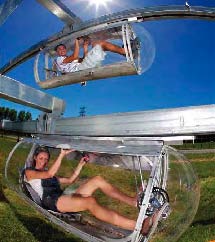Studded tires have bothered me for years. The driving on ruts, the road noise, the dangerous hydroplaning, and the costs to repair the roads are all concerns for me.
As a citizen activist, I contacted my legislator and the Oregon Department of Transportation, but couldn’t get any justifiable answers as to why studded tires are still legal. According to an Oregon legislative fact sheet, only 10 percent of drivers use studded tires west of the Cascades, yet they cut road life by 50 percent. They were banned in Minnesota in the 1970s and if any state has winter weather, its Minnesota.
 The more research I did, the more I learned it is more than just ruts and money, it’s also about the environment. Asphalt is made from oil, and if road life is cut in half, then we’re drilling, transporting, and refining twice as much oil when studded tires are used. According to the Washington State Department of Transportation, the average studded tire over its life chews up one-half to three-fourths of a ton of asphalt. That’s a fine dust that is in our air, on our land and eventually washed into our rivers and oceans.
The more research I did, the more I learned it is more than just ruts and money, it’s also about the environment. Asphalt is made from oil, and if road life is cut in half, then we’re drilling, transporting, and refining twice as much oil when studded tires are used. According to the Washington State Department of Transportation, the average studded tire over its life chews up one-half to three-fourths of a ton of asphalt. That’s a fine dust that is in our air, on our land and eventually washed into our rivers and oceans.
A Swedish study found that the toxic dust created by studded tires is 60 to 100 times higher than from regular tires. Stockholm air contains higher levels of harmful PM10 particles — tiny ones that are one to 10 micrometers — than Los Angeles because of studded tires. Tests have shown the dust to be the size that can lodge in your lungs. “These particles can also have inflammatory and toxic effect,” says Doug Brugge, professor of public health and community medicine at Tufts School of Medicine in Boston.
Japan banned studded tires in 1990 because of the toxic dust that was created. That’s when Bridgestone Tire developed the Blizzak all-weather snow and ice tire. An Alaskan study reported that the Blizzak outperformed studded tires in a wider range of winter driving conditions.
Almost everyone I met who has switched to the stud-less snow tire says they would never go back to using studded tires. They say they felt safer.
Concern with climate change is the biggest reason I pursued a 2012 ballot initiative to ban studded tires. Consuming and using a limited and expensive resource like oil will have negative consequences both for the environment and state budgets. Studies have shown that both gas mileage and tire life are reduced on rough roads versus smooth roads, so it becomes a carbon footprint issue.
Studded tire users claim their safety is most important and I feel the same way. Driving on rain-filled ruts is dangerous for all of us, year round. However, the Washington State Department of Transportation estimates that the need for studded tires occurs in only one percent of driving conditions. That equates to three to four days a year, which just doesn’t justify driving for five months with studded tires. Driving slower and using all-weather snow and ice tires during wintery conditions would solve that safety issue. Under extreme conditions, such as those encountered when driving to Timberline, Mt. Hood Meadows, Ski Bowl, etc, chains are the safest option.
Spending money to pay for roads has its own carbon footprint that needs to be considered when evaluating the impact of studded tires. Everything in our lives travels over the roads: our jobs, our food, and consumer goods. Until that changes, it’s in all our interest to protect our valuable infrastructure.
In 1996, an Oregon State University study suggested a ban first, then suggested a $140 fee to lessen the burden on the 84 percent of Oregonians that don’t use studded tires. My personal feeling is that with the advent of modern snow and ice tires, studded tires are obsolete.
Jeff Bernards of Portland was chief petitioner of a 2012 ballot initiative that would have banned the use of studded tires in Oregon. Bernards’ group is taking this issue to the 2013 legislature.
http://preservingoregonroads.com





